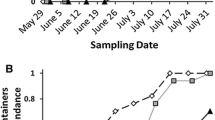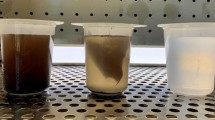Abstract
Predator-mediated coexistence of competitors occurs when a species that is superior in competition is also more vulnerable to a shared predator compared to a poorer competitor. The invasive mosquito Aedes albopictus is usually competitively superior to Ochlerotatus triseriatus. Among second instar larvae, A. albopictus show a lesser degree of behavioral modification in response to water-borne cues from predation by the larval midge Corethrella appendiculata than do O. triseriatus, rendering A. albopictus more vulnerable to predation by C. appendiculata than O. triseriatus. The hypothesis that C. appendiculata predation favors coexistence of these competitors predicts that C. appendiculata abundances will be negatively and positively correlated with A. albopictus and O. triseriatus abundances, respectively, and that coexistence will occur where C. appendiculata are common. Actual abundances of O. triseriatus, A. albopictus, and C. appendiculata in three habitats fit this prediction. In natural container habitats like tree holes, C. appendiculata were abundant and competitors co-existed at similar densities. In cemeteries and tires, which occur primarily in non-forested, human-dominated habitats, A. albopictus dominated, with abundances twice those found in tree holes, but C. appendiculata and O. triseriatus were rare or absent. We also tested for whether antipredatory behavioral responses of A. albopictus differed among habitats or populations, or were correlated with local C. appendiculata abundances. We could detect no differences in A. albopictus antipredatory behavioral responses to water-borne cues from predation. Tree hole habitats appear to promote co-existence of O. triseriatus and A. albopictus through interactions with predatory C. appendiculata, and this predator effect appears to limit invasion success of A. albopictus in tree holes. There are many studies on predator-mediated coexistence in natural habitats but to our knowledge this is the first study to suggest differential predator-mediated coexistence between natural and man-made habitats.




Similar content being viewed by others
References
Aliabadi BW, Juliano SA (2002) Escape from gregarine parasites affects the competitive interactions of an invasive mosquito. Biol Invasions 4:283–297
Bernal XE, Rand AS, Ryan MJ (2006) Acoustic preferences and localization performance of blood-sucking flies (Corethrella Coquillett) to tungara frog calls. Behav Ecol 17:709–715
Buskirk JV, McCollum SA, Werner EE (1997) Natural selection for environmentally induced phenotypes in tadpoles. Evolution 51:1983–1992
Ciros-Perez J, Carmona MJ, Lapesa S, Serra M (2004) Predation as a factor mediating resource competition among rotifer sibling species. Limnol Oceanogr 49:40–50
DeRivera CE, Ruiz GM, Hines AH, Jivoff P (2005) Biotic resistance to invasion: native predator limits abundance and distribution of an introduced crab. Ecology 86:3364–3376
Downes SJ, Adams M (2001) Geographic variation in antisnake tactics: the evolution of scent-mediated behavior in a lizard. Evolution 55:605–615
Garvey JE, Rettig JE, Stein RA, Lodge DM, Klosiewski SP (2003). Scale-dependent associations among fish predation, littoral habitat, and distributions of crayfish species. Ecology 84:3339–3348
Griswold M, Lounibos LP (2005a) Competitive outcomes of aquatic container Diptera depend on predation and resource levels. Ann Entomol Soc Am 98:673–681
Griswold MW, Lounibos LP (2005b) Does differential predation permit invasive and native mosquito larvae to coexist in Florida? Ecol Entomol 30:122–127
Griswold M, Lounibos LP (2006) Predator identity and additive effects in a treehole community. Ecology 87:987–995
Hawley WA, Reiter P, Copeland RS, Pumpuni CB, Craig Jr GB (1987) Aedes albopictus in North America: probable introduction in used tires from northern Asia. Science 236:1114–1116
Hawley WA (1988) The biology of Aedes albopictus. J Am Mosq Control Assoc 4:1–40
Holway DA, Suarez AV (1999) Animal behavior: an essential component of invasion biology. Trends Ecol Evol 14:328–330
Ibanez-Bernal BBS, Mutebi JP, Argot E, Rodriguez G (1997) First record in America of Aedes albopictus naturally infected with dengue virus during the 1995 outbreak at Reynosa, Mexico. Med Vet Entomol 11:305–309
Juliano SA, Gravel ME (2002) Predation and the evolution of prey behavior: an experiment with tree hole mosquitoes. Behav Ecol 13:301–311
Juliano SA, Hechtel LJ, Waters J (1993) Behavior and risk of predation in larval tree hole mosquitoes: effects of hunger and population history of predation. Oikos 68:229–241
Juliano SA, Lounibos LP (2005) Ecology of invasive mosquitoes: effects on resident species and on human health. Ecol Lett 8:558–574
Juliano SA, Reminger L (1992) The relationship between vulnerability to predation and behavior of larval tree-hole mosquitoes: geographic and ontogenetic differences. Oikos 63:465–467
Kats LB, Petranka JW, Sih A (1988) Antipredator defenses and the persistence of amphibian larvae with fishes. Ecology 69:1865–1870
Kesavaraju B, Alto BW, Lounibos LP, Juliano SA (2007a) Behavioural responses of larval container mosquitoes to a size-selective predator. Ecol Entomol 32:262–272
Kesavaraju B, Damal K, Juliano SA (2007b) Threat-sensitive behavioral responses to concentrations of water-borne cues from predation. Ethology 113:199–206
Kesavaraju B, Juliano SA (2004) Differential behavioral responses to water-borne cues to predation in two container-dwelling mosquitoes. Ann Entomol Soc Am 97:194–201
Kitching RL (2000) Food webs and container habitats. The natural history and ecology of phytotelmata. Cambridge University Press, Cambridge
Knutson MG, Sauer JR, Olsen DA, Mossman MJ, Hemesath LM, Lannoo MJ (1999) Effects of landscape composition and wetland fragmentation on frog and toad abundance and species richness in Iowa and Wisconsin, USA. Conserv Biol 13:1437–1446
Kolar CS, Lodge DM (2001) Progress in invasion biology: predicting invaders. Trends Ecol Evol 16:199–204
Lee CE (2002) Evolutionary genetics of invasive species. Trends Ecol Evol 17:386–391
Leibold MA (1996) A graphical model of keystone predators in food webs: trophic regulation of abundance, incidence, and diversity patterns in communities. Am Nat 147:784–812
Lima SL, Dill LM (1990) Behavioral decisions made under the risk of predation: a review and prospectus. Can J Zool 68:619–640
Livdahl TP, Willey MS (1991) Prospects for an invasion: competition between Aedes albopictus and native Aedes triseriatus. Science 253:189–191
Lodge DM (1993) Biological invasions: lessons for ecology. Trends Ecol Evol 8:133–136
Lounibos LP, O’Meara GF, Escher RL, Nishimura N, Cutwa M, Nelson T, Campos RE, Juliano SA (2001) Testing predictions of displacement of native Aedes by the invasive Asian tiger mosquito Aedes albopictus in Florida, USA. Biol Invasions 3:151–166
Lounibos LP, Escher RL, Lourenco-de-Oliveria R (2003) Asymmetric evolution of photoperiodic diapause in temperate and tropical invasive populations of Aedes albopictus (Diptera: Culicidae). Ann Entomol Soc Am 96: 512–518
McKeever S (1977) Observations of Corethrella feeding on tree frogs (Hyla). Mosquito News 37:522–523
McKeever S, Hartberg WK (1981) An effective method for trapping adult female Corethrella (Diptera, Chaoboridae). Mosquito News 40:111–112
Miyagi I (1974) On a blood-sucking Corethrella sp. collected in Nagasaki, Japan (Diptera: Chaoboridae). Trop Med 16:89–93
Morin PJ (1981) Predatory salamanders reverse the outcome of competition among 3 species of anuran tadpoles. Science 212:1284–1286
Novak MG, Higley LG, Christianssen CA, Rowley WA (1993) Evaluating larval competition between Aedes albopictus and A. triseriatus (Diptera, Culicidae) through replacement series experiments. Environ Entomol 22:311–318
O’Meara GF, Evans LF, Getman AD, Cuda JP (1995) Spread of Aedes albopictus and decline of Aedes aegypti (Diptera, Culicidae) in Florida. J Med Entomol 32:554–562
Phillips BL, Shine R (2004) Adapting to an invasive species: toxic cane toads induce morphological change in Australian snakes. Proc Natl Acad Sci USA 101:17150–17155
Phillips BL, Shine R (2005) The morphology, and hence impact, of an invasive species (the cane toad, Bufo marinus): changes with time since colonisation. Anim Conserv 8:407–413
Relyea RA (2000) Trait-mediated indirect effects in larval anurans: reversing competition with the threat of predation. Ecology 81:2278–2289
Relyea RA (2002) Local population differences in phenotypic plasticity: predator-induced changes in wood frog tadpoles. Ecol Monogr 72:77–93
Scheiner SM (2001) MANOVA: multiple response variables and multispecies interaction. In: Scheiner SM, Gurevitch J (eds) Design and analysis of ecological experiments, 2nd edn. Oxford University Press, New York, pp 99–115
Sih A (1984) The behavioral response race between predator and prey. Am Nat 123:143–150
Smith KG (2006) Keystone predators (eastern newts, Notophthalmus viridescens) reduce the impacts of an aquatic invasive species. Oecologia 148:342–349
Storfer A, Sih A (1998) Gene flow and ineffective antipredator behavior in a stream-breeding salamander. Evolution 52:558–565
Teng HJ, Apperson CS (2000) Development and survival of immature Aedes albopictus and Aedes triseriatus (Diptera: Culicidae) in the laboratory: effects of density, food, and competition on response to temperature. J Med Entomol 37:40–52
Turell MJ, Dohm DJ, Sardelis MR, O’Guinn ML, Andreadis TG, Blow JA (2005) An update on the potential of North American mosquitoes (Diptera : Culicidae) to transmit West Nile virus. J Med Entomol 42:57–62
Werner EE, Anholt BR (1996) Predator-induced behavioral indirect effects: consequences to competitive interactions in anuran larvae. Ecology 77:157–169
Acknowledgements
We thank R. Escher for providing C. appendiculata., the Department of Environmental Protection, Florida for permission to collect mosquitoes, L. P. Lounibos, Florida Medical Entomology Laboratory, Vero Beach, Florida for providing lab space, and L. P. Lounibos, C. F. Thompson, W. L. Perry, D. L. Byers, and two anonymous referees for useful comments on the manuscript. This research was supported by grants from the National Science Foundation (DEB no. #0507015), National Institute of Allergy and Infectious Disease (R01-AI44793, Illinois State University subcontract), and the Illinois State University Beta Lambda chapter of Phi Sigma.
Author information
Authors and Affiliations
Corresponding author
Additional information
Communicated by Carla Caceres.
An erratum to this article can be found at http://dx.doi.org/10.1007/s00442-008-1184-x
Electronic supplementary material
Below is the link to the electronic supplementary material.
Rights and permissions
About this article
Cite this article
Kesavaraju, B., Damal, K. & Juliano, S.A. Do natural container habitats impede invader dominance? Predator-mediated coexistence of invasive and native container-dwelling mosquitoes. Oecologia 155, 631–639 (2008). https://doi.org/10.1007/s00442-007-0935-4
Received:
Accepted:
Published:
Issue Date:
DOI: https://doi.org/10.1007/s00442-007-0935-4




